Now Reading: What Is a Marketing Plan & How to Write One [+ Examples]
-
01
What Is a Marketing Plan & How to Write One [+ Examples]
What Is a Marketing Plan & How to Write One [+ Examples]
![What Is a Marketing Plan & How to Write One [+ Examples] What Is a Marketing Plan & How to Write One [+ Examples]](https://i3.wp.com/www.hubspot.com/hubfs/marketing-strategy-examples-1-20240801-4880441-1.webp?w=1920&resize=1920,1267&ssl=1)
I’ve found that an airtight marketing plan is the key to going from strategic vision to measurable goal. If you’re wondering what goes into a marketing plan or why you need one, this is the place to start.
Below, I’ll walk you through how to write a marketing plan, the different types you can create, and share some helpful examples of marketing plans to use as inspiration for crafting your own.
By the end, you’ll be ready to begin implementing your marketing strategies — to take them from ideas to action. So, grab your free marketing plan template and let’s get started.
Table of Contents
What is a marketing plan?
A marketing plan is a strategic roadmap that businesses use to organize, execute, and track their marketing strategy over a given period. The purpose is to formalize your marketing efforts and implement your broader strategies in order to reach your target audience, attract leads, and generate sales. Your marketing plan will include each campaign‘s mission, buyer personas, budget, tactics, and deliverables.
Marketing Plan vs. Business Plan
Marketing plans and business plans are both strategic documents.
A business plan covers all aspects of a company’s operations, including goals, finances, purpose, and strategies.
A marketing plan is one aspect of a business plan. It shows how your marketing strategies and objectives will support your overall business goals, and provides detailed steps for how to carry them out.
Pro tip: If you’re wondering where to start with executing a marketing plan, I recommend HubSpot’s Marketing Hub.
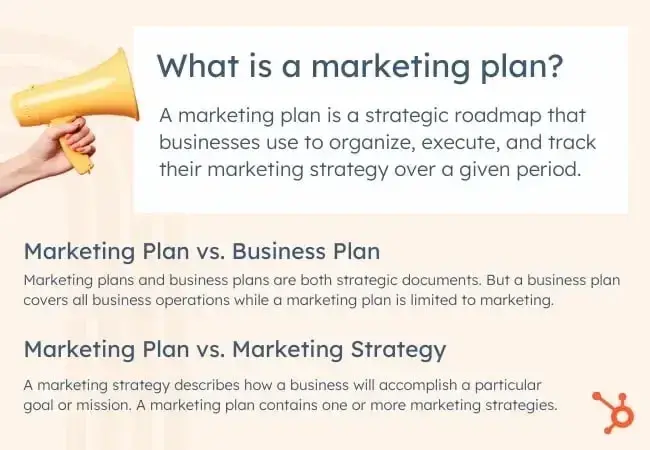
Marketing Plan vs. Marketing Strategy
A marketing plan is a detailed account of how you’ll execute your marketing strategy.
Marketing strategies are shaped by your business goals and come before a marketing plan can be written. That’s because the marketing plan is a step-by-step guide for how to accomplish your marketing strategies.
In other words:
- A marketing strategy will define why your marketing efforts are important for your business goals.
- A marketing plan will support that strategy with actionable steps.
So, for example, if my goal is to increase traffic to my website, my marketing strategy might be to run ads on social media. My marketing plan, then, would detail the campaigns, content, channels, and marketing software I’ll use to execute my strategy and track its success.
What’s included in a marketing plan?
Executive Summary
Here, you’ll state the purpose of your marketing plan and how it will help you accomplish your goals. This is a condensed overview of the entire plan, which should give critical information and also spark the interest of leadership and stakeholders to explore the plan further.
Target Market Analysis
This section will compile the efforts of your market research to identify your target audience. It can specify a new audience, or aim to reach a broader group within your target market.
Some characteristics to define are: location, age, lifestyle, attitudes, values, interests, and pain points, among others. This is also a place to build out buyer personas, indicating the audience you aim to attract.
Competitive Analysis
Introduce the companies you’re competing with for your target audience. Include their strengths, weaknesses, and strategies, as well as how you will gain market share in the context of the competition.
Marketing Strategies
Here, you’ll specify your marketing strategies — that is, your high-level approach to meeting your objectives. Outline the overall methods and how they’ll move you toward your goals.
For example, your strategy might be to implement a paid social media campaign to drive traffic to your ecommerce site.
Tactics
Tactics are the specific actions you’ll take to implement your strategies. These are detailed tasks and activities.
For example, if the strategy is to implement a paid social media campaign to drive traffic to your ecommerce site, then your tactics will specify everything about how to carry it out: channel, frequency, type, etc.
Budget and Calendar
This is where you take your tactics and define the timing and pricing of each. Plot out a weekly and monthly calendar showing when each tactic should be accomplished, and allocate a budget to go along with each point.
The budget should also include higher level costs, such as staffing, tech, or partnerships.
Metrics
You’ll need to define how to measure the success of your marketing plan. For this, discuss targets, such as number of new customers to be attained, market share, or sales volume. State your expected outcomes and how you’ll measure results.
How to Write a Marketing Plan
- State your business’ mission.
- Determine the KPIs for this mission.
- Identify your buyer personas.
- Describe your content initiatives and strategies.
- Clearly define your plan’s omissions.
- Define your marketing budget.
- Identify your competition.
- Outline your plan’s contributors and their responsibilities.
1. State your mission.
The first step in writing a marketing plan is to state your mission. Although this mission is specific to marketing, it should be tied to your business’ overarching goal.
If your business’ mission is “to make booking travel a delightful experience,” your marketing mission might be “to attract an audience of travelers, educate them on the tourism industry, and convert them into users of our bookings platform.”
Be specific, but keep it short (a few sentences). The rest of the marketing plan is the place to elaborate on how you’ll accomplish this mission.
If you need help building your mission statement, I like this guide with mission statement examples and templates to help me write the ideal mission statement.
And if you’re running a startup or small business, HubSpot’s starter bundle is a great all-in-one solution — it can help you find and win customers, execute content marketing plans, and more.
2. Determine the KPIs for this mission.
To describe how you’ll track your mission’s progress, you’ll need to decide on your key performance indicators (KPIs).
KPIs are individual metrics that measure the various elements of a marketing campaign. These units help you establish short-term goals within your mission and communicate your progress to business leaders.
Let’s continue with the same example from above. If part of your mission is “to attract an audience of travelers,” you might track website visits using organic page views. In this case, “organic page views” is one KPI, and you can see the number of page views grow over time.
Also, make sure to check whether your current reporting software facilitates the KPIs you need. Some reporting tools can only measure a set of pre-defined metrics, which can cause massive headaches in particular marketing campaigns.
However, other tools, like HubSpot’s analytics software, offer full flexibility over the KPIs you wish to track.
You can generate custom reports that reveal average website engagement rates, page visits, email, social media traffic, and more.
3. Identify your buyer personas.
A buyer persona is a description of who you want to attract. This can include age, sex, location, family size, and job title.
Each buyer persona should directly reflect your business’ current and potential customers. All business leaders should agree on your buyer personas.
Try out this Make My Persona tool to jumpstart this process.
4. Describe your content initiatives and strategies.
Here‘s where you’ll include the main points of your marketing and content strategy.
Because there are so many content types and channels available, explain how and why you chose each one.
I like to specify:
- What types of content I’ll create. These might include blog posts, YouTube videos, infographics, and ebooks.
- How much I’ll create. I typically describe content volume in daily, weekly, monthly, or even quarterly intervals. It all depends on my workflow and the short-term goals for my content.
- The goals (and KPIs) I’ll use to track each type. KPIs can include organic traffic, social media traffic, email traffic, and referral traffic. Your goals should also include which pages you want to drive that traffic to, such as product pages, blog pages, or landing pages.
- The channels on which I’ll distribute my content. Popular channels include Facebook, X, LinkedIn, YouTube, Pinterest, and Instagram.
- Any paid advertising that will take place on these channels.
5. Clearly define your plan’s omissions.
A marketing plan explains the marketing team’s focus. It also explains what the marketing team will not focus on.
If there are other aspects of your business that you aren’t serving in this particular plan, include them in this section. These omissions help to justify your mission, buyer personas, KPIs, and content.
In my experience, this section is particularly important for stakeholders to help them understand why certain decisions were made. And if your team isn’t on the hook for something in this round, you’ll need to make it known.
6. Define your marketing budget.
Whether it’s freelance fees, sponsorships, or a new full-time marketing hire, use these costs to develop a marketing budget and outline each expense in this section of your marketing plan.
You can establish your marketing budget with these 8 free marketing budget templates.
7. Identify your competition.
Part of marketing is knowing your competition. Research the key players in your industry and consider profiling each one.
A great way to go into depth on this is to run a comprehensive competitive analysis, which will uncover who your competitors are and in which aspects you compete with them. You can get started with this exercise using these 10 free competitive analysis templates.
8. Outline your plan’s contributors and their responsibilities.
With your marketing plan fully fleshed out, it’s time to delegate. For this step, I like to write out which teams and team leaders are in charge of specific content types, channels, KPIs, and all other aspects of the plan.
Now, I know starting a plan from scratch can be overwhelming. To ease that, in the next sections, I’ll share some of the best guides and templates to help you build effective results-driven plans for your marketing strategies.
Types of Marketing Plans
The type of marketing plan you create will depend on your company, your industry, and your business goals. Here, I’ll outline five common types, along with templates from real-world businesses and brands.
1. Quarterly or Annual Marketing Plans

Quarterly, annual, or any other time-based marketing plans highlight the strategies or campaigns you’ll take on during a certain period.
This template from Forbes highlights the 10 key sections you’ll need to include:
- Research
- Competitive analysis
- SWOT analysis
- Goals
- Objectives
- Target Markets
- Message
- Tactics
- Timeline
- Budget
Best for: If you’re lost on where to start with a marketing plan, I recommend this guide to help you define your target audience, strategize how to reach them, and develop a plan to ensure that the audience becomes loyal customers.
2. Social Media Marketing Plan
A social media marketing plan highlights the channels, tactics, and campaigns you intend to accomplish on social media.
One subtype of this is a paid marketing plan, which includes paid strategies like native advertising, PPC, and paid social media promotions.
To give an example of this type, I’ll use Shane Snow’s Marketing Plan, which he used to promote his book, Dream Teams. For this, he chose a data-driven content strategy framework known as the content strategy waterfall.

The content strategy waterfall, as defined by Economic Times, is a model used to create “a system with a linear and sequential approach.”
In Snow’s Contently article, he details how the waterfall model helped him successfully launch his new book. From it, I pulled out the following helpful advice:
- Apply your business objectives to decide which marketing metrics to track.
- Use your ultimate business goal of earning a certain amount in sales or garnering a certain number of purchases to estimate the conversion rate of each stage of your funnel.
- Create buyer personas to figure out the best channels for your target audience.
- Use your average post view on each of your marketing channels to estimate how much content you’ll need to create and how often to post on social media.
- Calculate how much earned and paid media could cut down the amount of content you have to create and post.
- Design your process and workflow, build your team, and delegate tasks.
- Analyze content performance metrics to refine your overall content strategy.
Best for: I use Snow’s marketing plan to think more creatively about my content promotion and distribution plan. I like that it’s linear, building on each prior step and creating an airtight strategy that doesn’t leave any details out.
3. Content Marketing Plan
A content marketing plan highlights the strategies, tactics, and campaigns in which you’ll use content to promote your business or product.
For this example, I’ll refer to HubSpot’s Comprehensive Guide for Content Marketing Strategy.

HubSpot built its marketing team from two business school graduates working from a coffee table to a powerhouse of thousands of employees. Along the way, countless lessons have shaped its current content marketing strategy.
HubSpot compiled its insights in a guide to teach marketers how to develop a successful content marketing strategy, regardless of their team’s size.
In this comprehensive guide for modern marketers, I found these key points:
- What content marketing is.
- Why your business needs a content marketing strategy.
- Who should lead your content marketing efforts.
- How to structure your content marketing team based on your company’s size.
- How to hire the right people for each role on your team.
- What marketing tools and technology you’ll need to succeed.
- What types of content your team should create, and which employees should be responsible for creating them.
- The importance of distributing your content through search engines, social media, email, and paid ads.
- And finally, the recommended metrics each of your teams should measure and report to optimize your content marketing program.
Best for: I think this is a fantastic resource for content teams of any size, whether one or one hundred. It includes how to hire and structure a content marketing team, what marketing tools you’ll need, what type of content you should create, and also recommends what metrics to track for analyzing campaigns.
Pro tip: If you’re aiming to establish or boost your online presence, try tools like HubSpot’s drag-and-drop website builder, which will help you create a digital footprint that sets the foundation for all your content marketing endeavors.
4. New Product Launch Marketing Plan
A new product launch marketing plan is a road map for promoting a new product. One of my favorite examples is the Go-To-Market Plan for a New Product by Chief Outsiders:

In this plan, I learned to:
- Validate a product.
- Write strategic objectives.
- Identify my market.
- Compile a competitive landscape.
- Create a value proposition for a new product.
- Consider sales and service in my marketing plan.
Best for: If you’re looking for a marketing plan for a new product, the Chief Outsiders’ template is a great place to start. Marketing plans for a new product will be more specific because they target only one product.
5. Growth Marketing Plan
Growth marketing plans use experimentation and data to drive results, like I found in Venture Harbour’s Growth Marketing Plan Template.
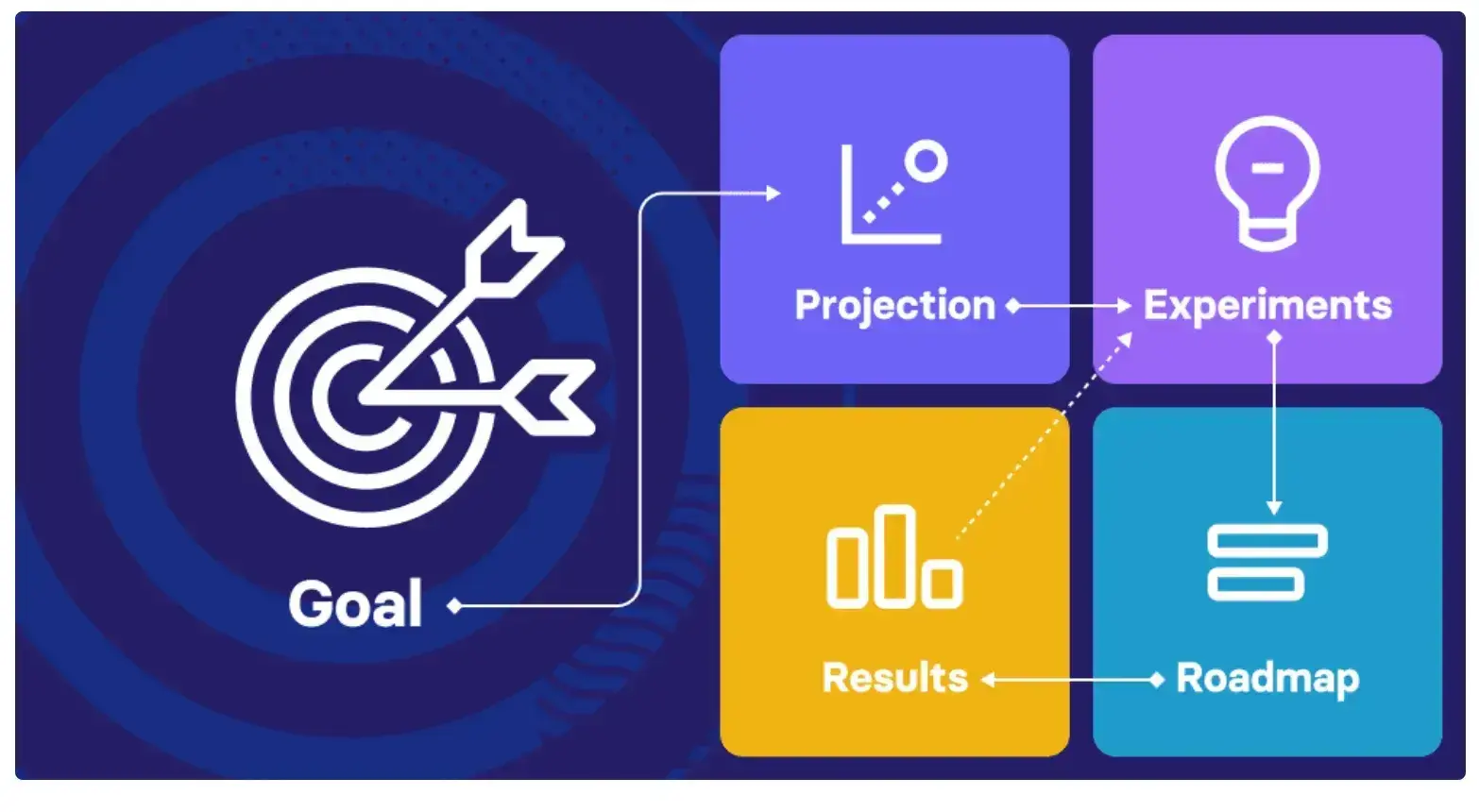
Venture Harbour’s growth marketing plan is a data-driven and experiment-led alternative to the more traditional marketing plan. This template has five steps, intended to allow refinement with every test-measure-learn cycle, which are:
- Goal
- Projection
- Experiments
- Road map
- Insights
Best for: I recommend this plan if you want to experiment with different platforms and campaigns. Experimentation can feel risky and unfamiliar, but this plan gives you a framework for accountability and strategy.
Sample Marketing Plan
To put all this information together, I’m going to outline the step-by-step creation of a sample marketing plan.
Psst! Follow along with HubSpot’s free marketing plan template.
1. Create an overview or primary objective.
Our business mission is to provide [service, product, solution] to help [audience] reach their [financial, educational, business related] goals without compromising their [your audience’s valuable asset: free time, mental health, budget, etc.]. We want to improve our social media presence while nurturing our relationships with collaborators and clients.
2. Determine the KPIs for this mission.
For example, if I wanted to focus on social media growth, my KPIs might look like this:
We want to achieve a minimum of [followers] with an engagement rate of [X] on [social media platform].
The goal is to achieve an increase of [Y] on recurring clients and new meaningful connections outside the platform by the end of the year.
3. Identify your buyer personas.
Use the following categories to create a target audience for your campaign.
- Age
- Gender
- Profession
- Background
- Interests
- Values
- Goals
- Pain points
- Social media platforms that they use
- Streaming platforms that they prefer
Pro tip: For more useful strategies, consider creating a buyer persona with HubSpot’s Make My Persona tool.
4. Describe your content initiatives and strategies.
Our content pillars will be: [X, Y, Z].
Content pillars should be based on topics your audience needs to know. If your ideal clients are female entrepreneurs, then your content pillars might be: marketing, being a woman in business, remote working, and productivity hacks for entrepreneurs.
Then, determine any omissions.
This marketing plan won’t be focusing on the following areas of improvement: [A, B, C].
5. Define your marketing budget.
Our marketing strategy will use a total of [Y] monthly. This will include anything from freelance collaborations to advertising.
6. Identify your competitors.
I like to work through the following questions to clearly indicate who my competitors are:
- Which platforms do they use the most?
- How does their branding differentiate?
- How do they talk to their audiences?
- What valuable assets do customers talk about? And if they are receiving any negative feedback, what is it about?
7. Outline your plan’s contributors and their responsibilities.
Create responsible parties for each portion of the plan.
Marketing will manage the content plan, implementation, and community interaction to reach the KPIs.
- Social media manager: [hours per week dedicated to the project, responsibilities, team communication requirements, expectations]
- Content strategist: [hours per week dedicated to the project, responsibilities, team communication requirements, expectations]
- Community manager: [hours per week dedicated to the project, responsibilities, team communication requirements, expectations]
- Sales will follow the line of the marketing work while creating and implementing an outreach strategy.
- Sales strategists: [hours per week dedicated to the project, responsibilities, team communication requirements, expectations]
- Sales executives: [hours per week dedicated to the project, responsibilities, team communication requirements, expectations]
- Customer Service will nurture clients’ relationships to ensure that they have what they want. [Hours per week dedicated to the project, responsibilities, team communication requirements, expectations].
- Project Managers will track the progress and team communication during the project. [Hours per week dedicated to the project, responsibilities, team communication requirements, expectations].
Marketing Plan FAQs
What is a typical marketing plan?
A typical marketing plan includes the following:
- Summary, mission, and objectives
- Target audience
- Competitive analysis
- Strategies
- Tactics
- Budget
- Metrics
For example, if I were leading a tech startup that’s launching a new mobile app, my marketing plan would include:
What should a good marketing plan include?
A good marketing plan is unique to your business. That said, most marketing plans will include the following sections:
- Detailed description of the product or service.
- Unique value proposition of the product or service.
- Target market analysis.
- Competitive analysis.
- Comprehensive marketing strategy, including online and offline channels.
- Strategic marketing mix details (such as product, price, place, and promotion).
- Budget.
- Measurable goals with defined timelines.
What are the most important parts of a marketing plan?
A marketing plan is developed by looking at your marketing strategy and your business goals, and then creating steps to take you from the “what” and “why” of your strategy to exactly “how” you’ll reach your end goals.
While each plan will look different, you can use this checklist to ensure that all the important steps are covered, if necessary:
- Marketing goals
- Executive summary
- Target market analysis
- Competitive analysis
- Marketing strategies
- Tactics
- Budget
- Metrics
What questions should I ask when making a marketing plan?
Try using one or more of these questions as a starting point when creating your marketing plan:
- Who is my target audience?
- What are their needs, motivations, and pain points?
- How does my product or service solve their problems?
- How will I reach and engage them?
- Who are my competitors? Are they direct or indirect competitors?
- What are the unique selling points of my product or service?
- What marketing channels are best for the brand?
- What is my budget and timeline?
- How will I measure the success of marketing efforts?
How much does a marketing plan cost?
The marketing plan itself may not cost much, but the cost of executing a marketing plan will vary by business, industry, and scope, as well as whether your team handles marketing in-house or hires external consultants.
Total costs can range from a few thousand dollars to tens of thousands, and should be assessed to include in your marketing plan budget (yes, there are free marketing budget templates for that!)
Marketing Plan Examples
- Louisville Tourism
- Lush
- Timberland Regional Library
- Northeast Climate Hub
- Wright County Economic Development
- The Cultural Council of Palm Beach County
- Cabarrus County Convention and Visitors Bureau
- Visit Billings
1. Louisville Tourism

I find this marketing plan to be a masterclass for companies in the tourism industry. It’s comprehensive, and divides its target market into growth and seed categories to allow for more focused strategies.
For example, the plan recognizes millennials in Chicago, Atlanta, and Nashville as the core of its growth market, whereas people in Boston, Austin, and New York represent seed markets where potential growth opportunities exist. Then, the plan outlines objectives and tactics for reaching each market.
Why I Think This Marketing Plan Works
- The plan starts with a letter from the president and CEO of the company, who sets the stage by providing a high-level preview of the incoming developments for Louisville’s tourism industry.
- The focus on Louisville as “Bourbon City” effectively leverages its unique cultural and culinary attributes to present a strong brand.
- It incorporates data from Google Analytics, Arrivalist, and visitor profiles to define their target audience with a data-informed approach.
2. Lush
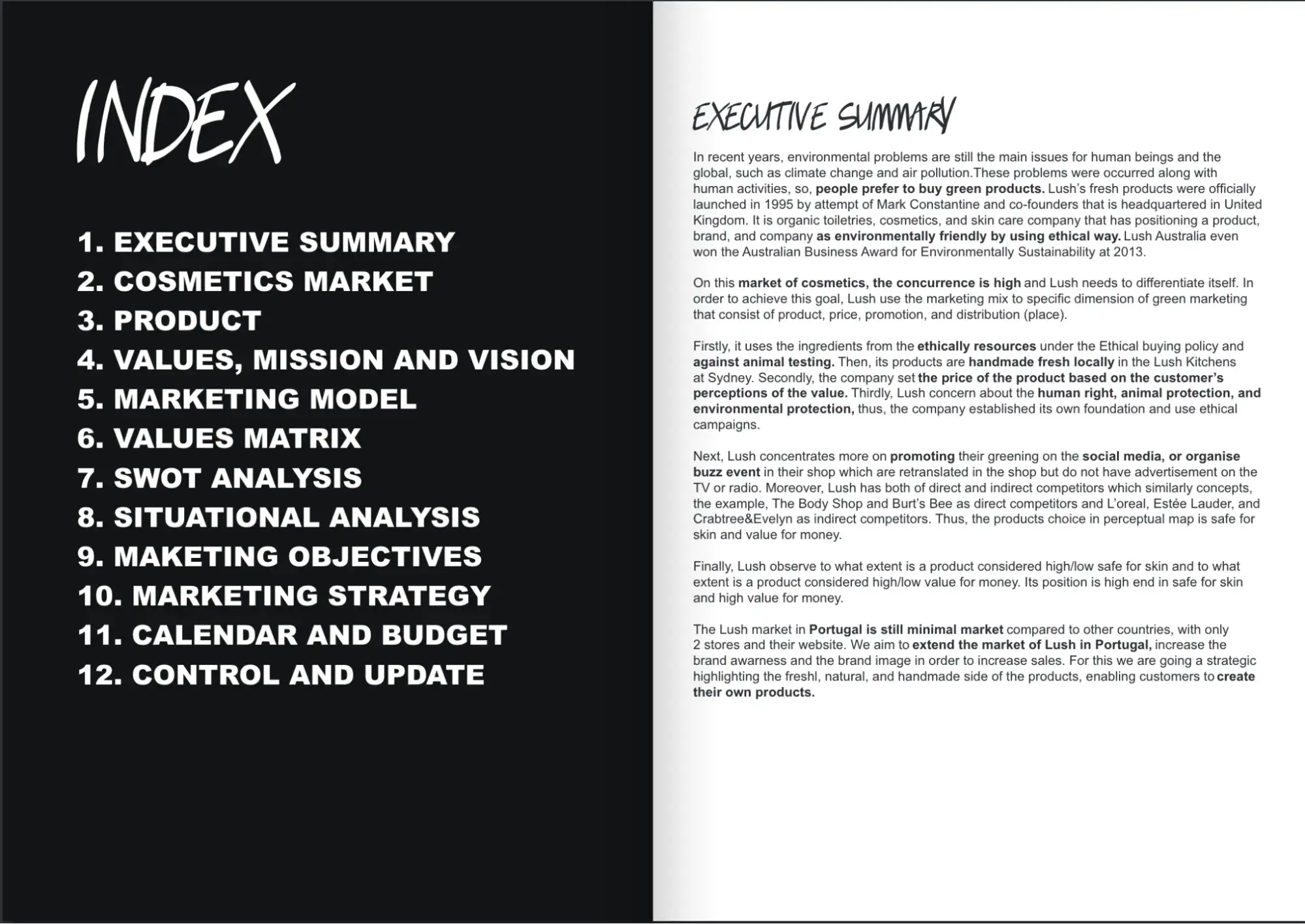
The marketing plan for cosmetics company Lush is a 33-page digital flipbook created for its move into the Portuguese market. The executive summary contextualizes the company in the market for green products, linking its mission to environmental responsibility as its hook and selling point.
The one-page summary goes on to outline its target audience (people who prefer green products), how it differentiates itself from the competition (ethically sourced, handmade products), and its strategic vision for entering Portugal (increasing brand awareness by allowing customers to create their own products).
The rest of the plan addresses the history of the company, the state of the global cosmetics market, and Lush’s products, values, and tactics – including photos from prior successful launches. It’s got all the parts of a successful marketing plan, even a colorful diagram of its budget and calendar.
Why I Think This Marketing Plan Works
- It’s thorough, with a well-researched state-of-the-market section that places it in the context of other global cosmetics companies.
- The first paragraph clearly links its mission to a topic of greater global importance, giving weight to the business and its goals.
- It leverages prior successes to show how it will make a similar impact in the new market.
3. Timberland Regional Library
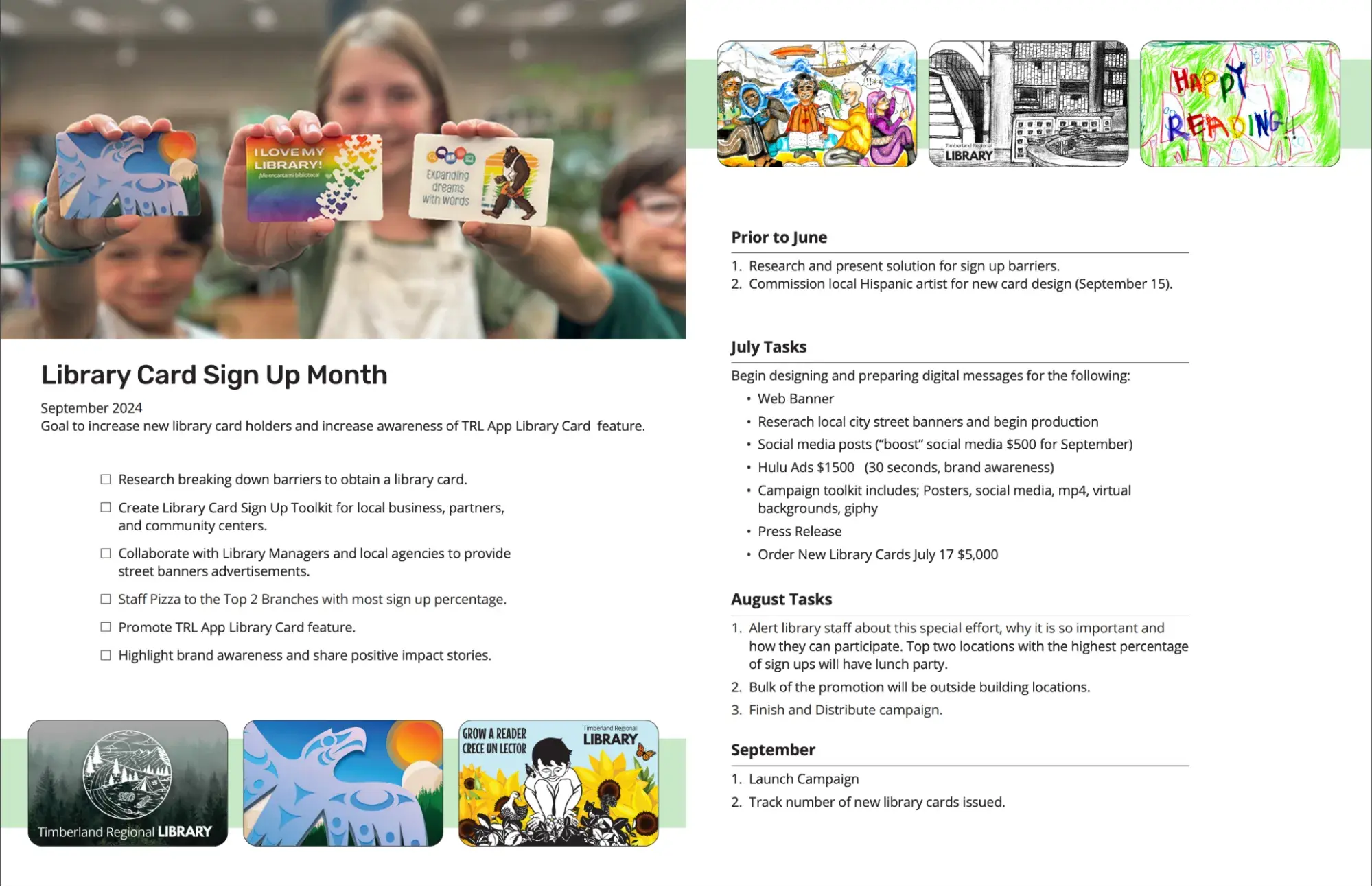
This two-year marketing plan for Timberland Regional Library has four very strategic goals: increase brand awareness in the surrounding counties, promote impact stories, create new marketing videos, and add new marketing locations.
It breaks down the plan into district-wide campaigns and major projects, laying out the specific tactics to meet its goals (from a new podcast to a sign-up month aimed at new library card holders). The tasks are broken down by month for both promotion and production.
Why I Think This Marketing Plan Works
- It’s simple, visually appealing, and has clear goals.
- With a local geographic audience, it understands its target market well and defines how it will reach them through specific channels online and offline.
- It targets a single time period of two years and breaks down its marketing efforts by month.
4. Northeast Climate Hub

This marketing plan is from the Northeast Climate Hub of the U.S. Department of Agriculture, promoting its first feature-length environmental documentary, Delmarva and the Ground for Change.
In an easily skimmable 34-page PDF, it uses each slide for a single component of its plan. The product overview gets a slide, for example, where dense summary text is offset by an image from the film. On another slide, its one-line mission statement is by itself, creating impact through the surrounding blank space.
Using SMART marketing goals and core marketing messages, the plan goes into depth about its three target markets and then showcases four distinct audience personas that it aims for.
Why I Think This Marketing Plan Works
- Presented as slides, with only one piece of information per page, the components of the plan are easy to digest.
- Dedicated to a clear color scheme, the text and images become a cohesive whole, creating an engaging presentation.
- Its competitor analysis lists other environmental documentaries that could take interest away from this one, and establishes its position amongst them with a simple graph.
5. Wright County Economic Development
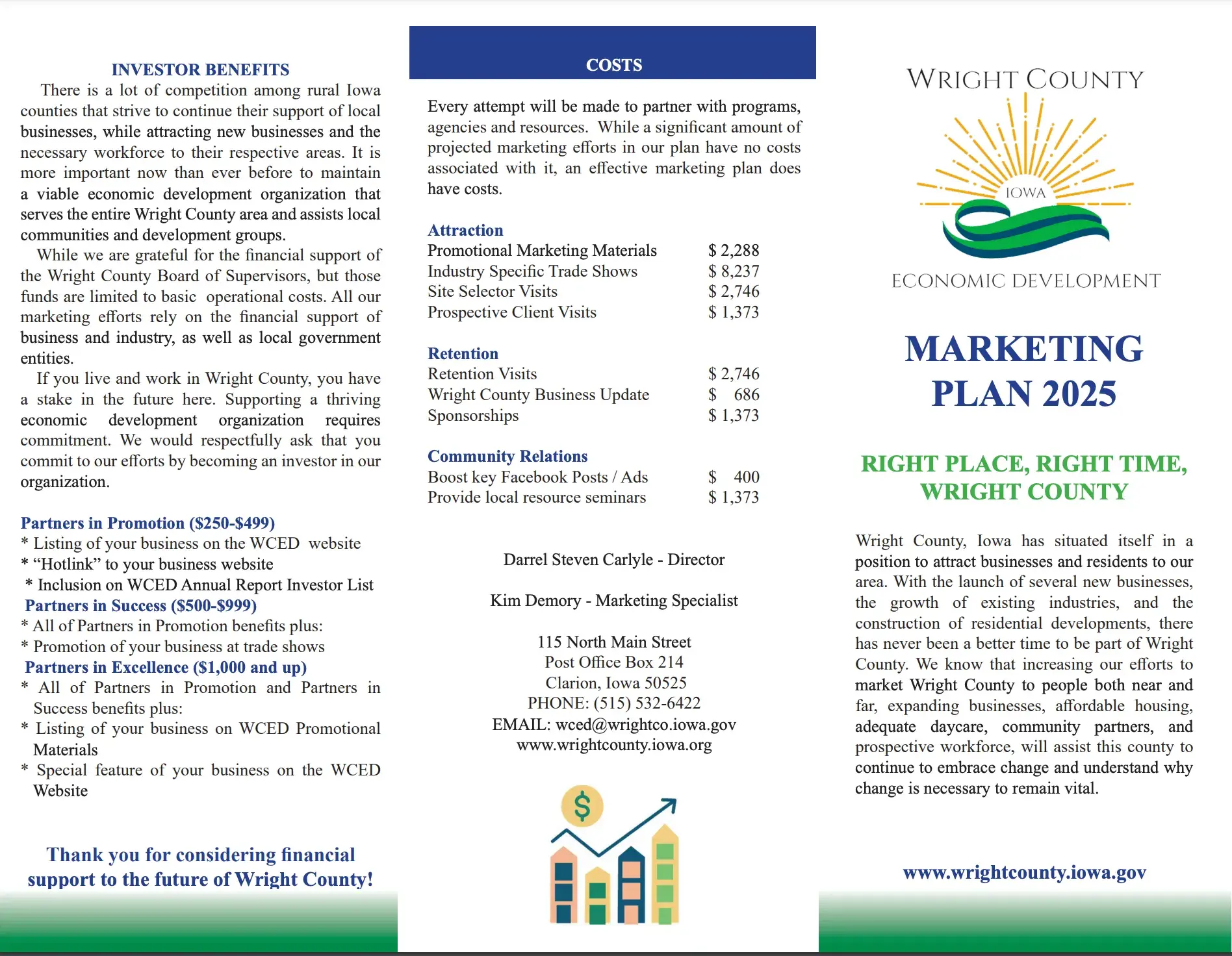
Wright County Economic Development’s plan drew my attention for its simplicity, making it good inspiration if you’d like to outline your plan in broad strokes without frills or filler.
It includes key information, such as marketing partners, goals, initiatives, and costs. The sections are easy to scan, but also contain plenty of information for those who like to dig into the details.
Most importantly, it includes a detailed breakdown of projected costs per marketing initiative, which is critical for upper-level managers and other stakeholders.
Why I Think This Marketing Plan Works
- It begins with a quick paragraph stating why the recommended changes are important.
- It uses clear graphics and bullet points to emphasize key points.
- It includes specific budget data to support decision-making.
6. The Cultural Council of Palm Beach County

This marketing plan by a cultural council is a great example of how to use data effectively. It also offers extensive details of specific marketing strategies.
For instance, one slide is dedicated to the county’s cultural tourism trends, and the plan also makes sure to mention what an arts and culture agency is in the first place — which is important when presenting to unfamiliar audiences. Defining terms at the beginning is a great way to get stakeholders to understand your organization and the importance of what you do, like in this example.
Why I Think This Marketing Plan Works
- It uses quality design and images to support the goals and priorities in the text.
- There are separate pages for each big idea or new strategy.
- It includes sections for awards and accomplishments to show how the marketing plan supports wider business goals.
- It defines strategies and tactics for each channel for easy skimming.
7. Cabarrus County Convention & Visitors Bureau
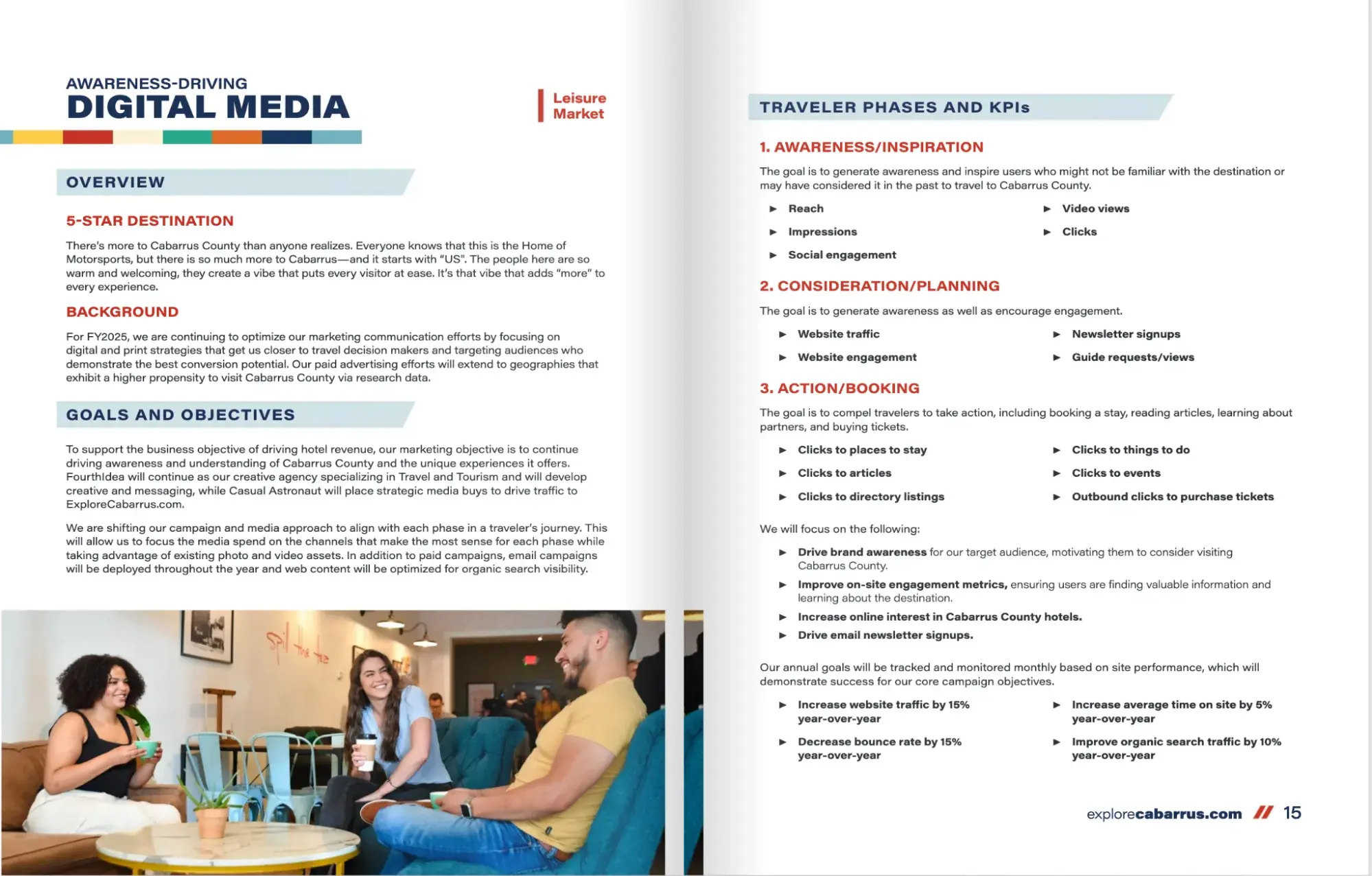
The Cabarrus County Convention & Visitors Bureau takes a slightly different approach with its marketing plan, formatting it like a physical magazine.
It offers information on the county’s target audience, channels, goals, KPIs, and public relations initiatives, as well as its tactical digital media strategies.
I especially love that the plan includes contact information for the bureau’s staff, so it’s easy for stakeholders to contact the appropriate person for a specific query.
Why I Think This Marketing Plan Works
- It uses infographics to expand on specific concepts, like how visitors benefit a community.
- It highlights the team members responsible for each initiative with a photo to emphasize accountability and community.
- It closes with an event calendar for transparency into key dates for events.
8. Visit Billings

The marketing plan for tourism to Billings, Montana, is laid out like a 52-page pamphlet, full of colorful photos of the life and landscape of the city. It uses infographics to convey bits of information and goes into detail about why tourism is important at this moment in time for the local economy.
It’s told like a story, starting with an “about Billings” section, and moving on to key business metrics from recent years as a benchmark for their current initiatives.
Since their target markets are related to regional geographics, it includes a map with regular flights from nearby cities, showing how people arrive in Billings. All of this is housed in a context that tells about the state of the American traveler right now.
Why I Think This Marketing Plan Works
- It’s vibrant and displays the local landscape that it’s trying to draw visitors to.
- In between all the parts of a basic marketing plan, it includes facts and figures to increase interest in the area.
- Information is presented visually from maps to graphics to photos, giving a sense of the place and what it has to offer, as well as what’s worked in the past and how they’ll meet their current goals.
Get started on your marketing plan.
The marketing plan sample and templates I’ve included are only initial resources to get you started. To deliver what your audience wants and needs, you’ll need to test out ideas, measure their success, and refine your plan as you go.
The key thing I try to remember is that there’s no one-size-fits-all when it comes to marketing plans. Whatever steps you devise to take you from marketing strategy to measurable outcome will be unique to your business and its goals.
Editor’s note: This post was originally published in June 2018 and has been updated for comprehensiveness.



![Download Now: Free Marketing Plan Template [Get Your Copy]](https://no-cache.hubspot.com/cta/default/53/aacfe6c7-71e6-4f49-979f-76099062afa0.png)











.png?w=1024&resize=1024,1024&ssl=1)
:max_bytes(150000):strip_icc()/GettyImages-2179215225-94d308b756914d858c4e9736089943ef.jpg?w=1920&resize=1920,1267&ssl=1)






